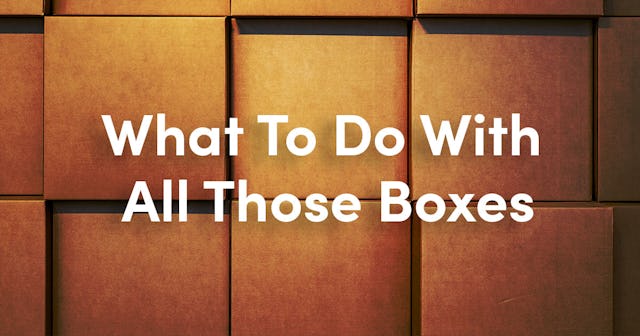What To Do With All Those Boxes

There are a few tangible items that we all probably forever associate with this year that has been like no other. Lysol, masks, hand sanitizer, and cardboard shipping boxes.
At first glance, one of those doesn’t look like the others. Hint: it’s the only item on the list that isn’t used for cleaning our surfaces or our hands, or reducing the spread of asymptomatic or pre-symptomatic infection.
If you guessed cardboard shipping boxes you’d be right. And while it’s true that cardboard shipping boxes aren’t truly pandemic-specific — they were around long before the world ever heard the name COVID-19 and will certainly be around longer after COVID is eradicated (fingers crossed that’s sooner than later) — if you think about it, cardboard boxes are crucial to pandemic life. In a different way than masks and hand sanitizers, shipping boxes have also played an important role in keeping us safe and virus-free. They’ve allowed us to receive what we need from the outside world without going out. Rather than go out, potentially exposing ourselves and our community to a deadly virus, many stayed in and ordered in, and our purchases arrived in neat little (or big) cardboard boxes. (Big thank you to the people who made those deliveries possible.)
The reliance on cardboard boxes during this pandemic is no more obvious than when Cyber Monday rolled around. Cyber Monday this year was the biggest online shopping day ever. According to Adobe Analytics, consumers spent $12 million dollars per minute on everything from toys to clothes and appliances during the peak hour of 8 p.m. to 9 p.m.
Which means—boxes. Lots and lots of cardboard boxes were delivered to lots and lots of doorsteps.
Which also means lots and lots of extra waste.
Luckily cardboard shipping boxes are recyclable, and the majority of American households recycle those boxes, but recycling isn’t the only option. Shipping boxes are also well-suited for upcycling.
“The good news is that shipping boxes are fully recyclable, and they can be upcycled into holiday or other DIY projects,” Mary Anne Hansan, Paper and Packaging Board president, tells Scary Mommy.
The Paper and Packaging Board (P+PB) has launched a fun recycling initiative called the Upcycled Gift Box Challenge, which challenges you to repurpose your cardboard shipping box into something fun and useful.
First, what is Upcycling?
Grassetto/Getty
Upcycling, as defined by dictionary.com, is the process of using good or waste material “so as to produce something that is often better than the original.”
“Upcycling everyday shipping boxes gives them a new life, even before placing them in the recycling bin. And, when they are recovered, our industry reuses them to make more boxes and products we all need,” says Hansan.
Upcycling Ideas
Some of the upcycling ideas P+PB encourages include creating an advent calendar, a plant station, or a wine gift box (for showing off the label of that special bottle). Printable step-by-step instructions for making these cute and eco-friendly gifts can be found on P+PB’s website.
A quick Google search revealed that folks are upcycling their cardboard boxes for use by pets—as dog houses or cat scratching posts—for storage or drawer dividers, and even for use as home décor.
Anyone who has ever gifted a kid a toy that has come in a giant cardboard box knows that often the box is more fun than whatever expensive toy was packaged within. That was definitely true in my house. With a little imagination, shipping boxes can be used as forts, hide outs, or peek-a-boo venues. With a little more imagination and some glow-in-the-dark paint, cardboard boxes can be transformed into your child’s favorite in-home planetarium. And, if you don’t mind a little contained mess, you can let your kids get into the box and use fingers, paintbrushes, or even their favorite cars or truck, to paint a mural on the inside of the box. Or, make a cake–with some shaving cream as icing and other arts and crafts supplies as the toppings, you can turn your box into a cake that’s perfect for sensory play.
For those who are craftier than I am, those shipping boxes can be turned into child-sized cars (with the help of a few paper plates as wheels and paper cups as headlights), life-sized gingerbread houses, airplanes and rocket ships, and a personalized child’s mailbox. Kids can turn cardboard boxes into astronaut helmets, tunnels for train tracks, robots, or treasure chests.
The shipping boxes can also be upcycled into tools to get out emotions or even burn off energy. My son’s art therapist recently asked us to upcycle a shipping box for use as a therapy tool. My son decorated the box and is filling it with items that he can turn to when his temper gets the best of him. A fellow writer recently shared that her child with ADHD takes the boxes outside to destroy them with a rubber mallet before throwing them into recycling and also asks his parents to video him jumping on the boxes.
It’s a year unlike any other, a year when those of us who are able to work, school, and shop from home are in order to help stop the virus from spreading. But all that online shopping means more shipping boxes, which means more waste, and even COVID-19 isn’t a reason to ignore the fact that what we do has an environmental impact.
This article was originally published on